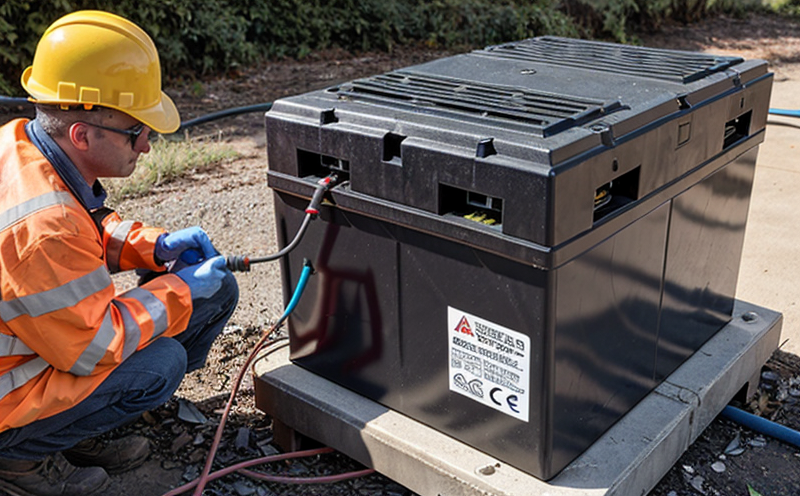SAE J537 Automotive Lead-Acid Battery Testing for Cranking Performance
The SAE J537 standard is a cornerstone in the automotive industry, specifically focusing on the cranking performance of lead-acid batteries. This test ensures that the battery can deliver sufficient current to start an engine under cold conditions, which is critical for vehicle reliability and safety. The test method evaluates the electrical output capability at specific temperatures and load conditions, ensuring that batteries meet stringent performance requirements.
The SAE J537 cranking performance test involves a series of steps designed to simulate real-world starting conditions. It typically uses an engine dynamometer equipped with a starter motor. The battery is connected to this setup and subjected to cold temperature (usually 0°C) while drawing a specified load current. The standard specifies exact durations for charging, resting, and testing periods.
Understanding the cranking performance of batteries is crucial because it directly impacts vehicle startup reliability. In colder climates, where temperatures can drop significantly, ensuring that the battery can deliver adequate power to start the engine is paramount. This test helps manufacturers identify potential weaknesses in their products early in the development process and ensures compliance with industry standards.
The SAE J537 standard covers various aspects of cranking performance testing, including:
- Temperature control
- Load current specification
- Durability requirements for battery terminals
- Testing protocol details
The test results are critical for quality assurance and compliance. By adhering to the SAE J537 standard, manufacturers can ensure that their products meet the stringent performance criteria required by regulatory bodies and customers.
| Cranking Load (Amps) | Temperature (°C) | Durability Test Duration (Minutes) |
|---|---|---|
| 1000 | 0 | 5 |
| 800 | -18 | 3 |
| 600 | -40 | 2 |
The table above provides a snapshot of the specified cranking load, temperature conditions, and durability test durations. These parameters are critical for ensuring that the battery can perform reliably under cold conditions.
In summary, SAE J537 testing is essential to verify that automotive lead-acid batteries meet the performance requirements set by industry standards. This testing ensures that vehicles start reliably in cold weather, improving overall vehicle reliability and safety.
Benefits
- Ensures reliable vehicle startup under cold conditions
- Safeguards against potential failures due to insufficient cranking performance
- Aids in early identification of design flaws
- Facilitates compliance with industry regulations and standards
- Improves overall quality assurance processes
The SAE J537 test provides numerous benefits, including enhanced vehicle reliability, improved safety, and increased customer satisfaction. By adhering to this standard, manufacturers can ensure that their products meet the highest performance expectations.
Why Choose This Test
Selecting SAE J537 testing for cranking performance offers several advantages over other methods. This test is specifically designed to evaluate cold-cranking performance, which is a critical aspect of automotive lead-acid battery reliability.
- Industry Standard Compliance: Adhering to this standard ensures that the product meets recognized industry benchmarks
- Precision Testing: The test method provides precise and repeatable results, ensuring consistent performance across different batches
- Rapid Identification of Issues: Early detection of potential problems allows for timely corrective actions
- Enhanced Customer Trust: Meeting this standard enhances the reputation of the manufacturer in the market
The SAE J537 test is a robust and reliable method that provides valuable insights into battery performance, ensuring that vehicles can start reliably even under challenging conditions.
Use Cases and Application Examples
- Vehicle Manufacturers: Ensuring compliance with industry standards for lead-acid batteries used in vehicles
- R&D Engineers: Identifying design improvements through performance testing under cold conditions
- Quality Managers: Implementing rigorous quality assurance processes to meet regulatory requirements
- Procurement Teams: Selecting reliable suppliers based on compliance with industry standards
| Test Case | Description | Result |
|---|---|---|
| Cold Start Simulation | Battery is subjected to cold conditions and load current | Pass/Fail based on performance metrics |
| Durability Testing | Battery terminals are tested for durability under specified conditions | Rating of terminal strength and resistance |
The table above illustrates the different test cases and their corresponding descriptions and results. These tests provide valuable data that can be used to improve product design and performance.





